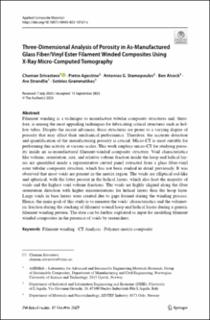| dc.contributor.author | Srivastava, Chaman | |
| dc.contributor.author | Agostino, Pietro | |
| dc.contributor.author | Stamopoulos, Antonios G. | |
| dc.contributor.author | Alcock, Benjamin | |
| dc.contributor.author | Strandlie, Are | |
| dc.contributor.author | Grammatikos, Sotirios | |
| dc.date.accessioned | 2024-02-12T10:00:09Z | |
| dc.date.available | 2024-02-12T10:00:09Z | |
| dc.date.created | 2023-10-30T12:31:26Z | |
| dc.date.issued | 2023 | |
| dc.identifier.issn | 0929-189X | |
| dc.identifier.uri | https://hdl.handle.net/11250/3116814 | |
| dc.description.abstract | Filament winding is a technique to manufacture tubular composite structures and, therefore, is among the most appealing techniques for fabricating critical structures such as hollow tubes. Despite the recent advances, these structures are prone to a varying degree of porosity that may affect their mechanical performance. Therefore, the accurate detection and quantification of the manufacturing porosity is crucial. Micro-CT is most suitable for performing this activity at various scales. This work employs micro-CT for studying porosity inside an as-manufactured filament-winded composite structure. Void characteristics like volume, orientation, size, and relative volume fraction inside the hoop and helical layers are quantified inside a representative curved panel extracted from a glass fiber-vinyl ester tubular composite structure, which has not been studied in detail previously. It was observed that most voids are present in the matrix region. The voids are elliptical rod-like and spherical, with the latter present in the helical layers, which also host the majority of voids and the highest void volume fractions. The voids are highly aligned along the fiber orientation direction with higher misorientations for helical layers than the hoop layer. Large voids in base layers were created due to gaps formed during the winding process. Hence, the main goal of this study is to measure the voids' characteristics and the volumetric fraction during the stacking of filament wound hoop and helical layers during a generic filament winding pattern. The data can be further exploited as input for modeling filament winded composites in the presence of voids by researchers. | en_US |
| dc.language.iso | eng | en_US |
| dc.publisher | Springer Nature Ltd. | en_US |
| dc.rights | Navngivelse 4.0 Internasjonal | * |
| dc.rights.uri | http://creativecommons.org/licenses/by/4.0/deed.no | * |
| dc.title | Three-Dimensional Analysis of Porosity in As-Manufactured Glass Fiber/Vinyl Ester Filament Winded Composites Using X-Ray Micro-Computed Tomography | en_US |
| dc.title.alternative | Three-Dimensional Analysis of Porosity in As-Manufactured Glass Fiber/Vinyl Ester Filament Winded Composites Using X-Ray Micro-Computed Tomography | en_US |
| dc.type | Peer reviewed | en_US |
| dc.type | Journal article | en_US |
| dc.description.version | publishedVersion | en_US |
| dc.source.pagenumber | 171-200 | en_US |
| dc.source.volume | 31 | en_US |
| dc.source.journal | Applied Composite Materials | en_US |
| dc.identifier.doi | 10.1007/s10443-023-10167-z | |
| dc.identifier.cristin | 2189920 | |
| cristin.ispublished | true | |
| cristin.fulltext | original | |
| cristin.qualitycode | 1 | |

